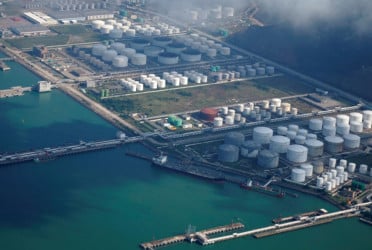The United States sent a reconnaissance aircraft while Japan and the Philippines deployed naval ships for a joint patrol in the contested South China Sea on Friday, reports AP.
This operation took place two days after the allied nations condemned the actions of Chinese coast guard vessels that targeted Philippine patrol ships.
According to the U.S. Indo-Pacific Command, the patrol was carried out in the Philippines' exclusive economic zone by allied nations and partners to "uphold the right to freedom of navigation and overflight" and other lawful maritime and airspace activities. These terms are commonly used by the US, Japan, and the Philippines to counter China's assertive actions in the disputed region.
Two Philippine security officials revealed that the patrol occurred approximately 40 nautical miles (74 kilometers) from Scarborough Shoal, a contested fishing area located off the northwestern Philippines. The officials spoke on condition of anonymity due to restrictions on public disclosures.
China claims almost the entire South China Sea and has increasingly guarded it with its coast guard, navy, and suspected militia vessels, clashing with forces from other claimant nations such as the Philippines, Vietnam, Malaysia, and Brunei. Indonesia has also faced confrontations with Chinese coast guard ships in the gas-rich Natuna waters in the southern part of the sea.
The joint patrol, part of a series of recent operations by the Philippines, the US, and their partners, had been postponed due to multiple typhoons affecting the region. It was not a response to the confrontation on Wednesday, which involved Chinese and Philippine vessels near Scarborough Shoal, according to the two Philippine officials.
The Philippine coast guard reported that Chinese coast guard vessels, supported by navy ships, used powerful water cannons and blocked and sideswiped a smaller Philippine fisheries vessel that was being escorted by Philippine coast guard ships near the shoal. The Philippine vessels were delivering supplies to Filipino fishermen in the area, which has been under close Chinese surveillance since a 2012 territorial standoff.
In response, the Philippine Department of Foreign Affairs lodged a formal protest against the Chinese actions.
The Chinese coast guard offered its version of events, claiming that the Philippine vessels had intruded into Chinese territory, prompting their response. Without providing evidence, they asserted that a Philippine vessel's manoeuvre led to the collision.
The hostilities, which have become more frequent since last year, have drawn concern from the United States, Japan, the European Union, and other Western allies. Japan, which also has territorial disputes with China in the East China Sea, stated that "the use of water cannon and obstructive manoeuvres undermine the safety of ship and crew." Ambassador to Manila, Endo Kazuya, expressed Japan’s stance, affirming its commitment to the rule of law and opposing actions that heighten tensions.
Japan is providing 1.6 billion yen ($10.6 million) in security assistance to strengthen the Philippine navy, including coastal radars, inflatable boats, and other defense equipment for better surveillance of Philippine waters, including the South China Sea. Japan has also aided in enhancing the Philippine air force's radar capabilities, according to both nations.
The US has reiterated its commitment to defending the Philippines, a treaty ally, should Filipino forces be attacked in the South China Sea. This defense pledge has enjoyed strong bipartisan backing in Washington, which Philippine officials anticipate will continue under the next administration.
bd-pratidin/Rafid







































































